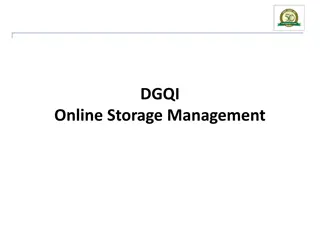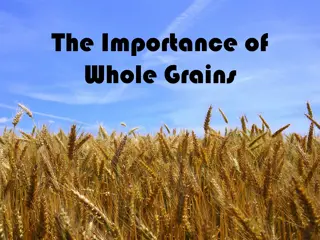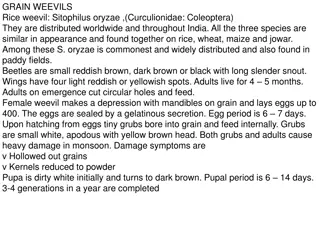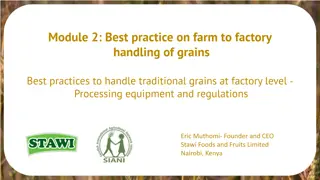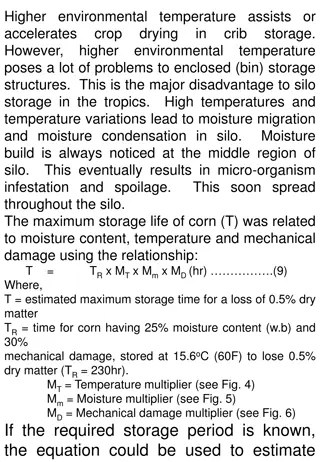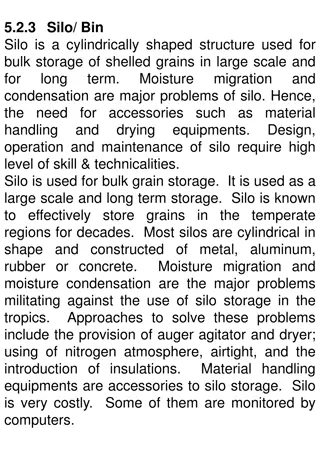Challenges and Opportunities in Scientific Storage of Grains
Globally, significant losses in food grains occur due to inadequate storage facilities, highlighting the urgent need for modernization and investment in grain storage infrastructure. Countries like India, USA, Canada, and China face varying challenges in grain storage practices, emphasizing the importance of adopting international best practices for efficient grain storage and movement.
Download Presentation

Please find below an Image/Link to download the presentation.
The content on the website is provided AS IS for your information and personal use only. It may not be sold, licensed, or shared on other websites without obtaining consent from the author. Download presentation by click this link. If you encounter any issues during the download, it is possible that the publisher has removed the file from their server.
E N D
Presentation Transcript
Challenges and Opportunities for Scientific Storage of Grains 1
Alarm Bells It is estimated that globally we loose about 1/3rd of the total food produced. Harvest to Household losses in our country may actually be more than the grain exports from Australia. Current covered storage capacity with FCI is very low against the requirement. About 12 Mn T Wheat is still lying in open under Cap Storage waiting to be evacuated. And new crop is about to arrive. Private sector investment in Agriculture has gone down from around 12% in 1999-2000 to less than 6% currently.
Indian Scenario We produce about 250 Mn T of Food Grain Wheat production has skyrocketed on the strength of Govt. buying. Corn production has gone up sharply with states like Karnataka and Bihar have done wonders in Corn production. Warehousing capacity has not kept pace with this increase and has resulted in Storage Gap of 35 Mn T As on 1st March, FCI is holding 62.8 Mn T of Wheat and Rice. The procurement target of wheat this year is 44 million tons. We are staring at impending disaster.
Flat Storage v/s Vertical Silos Debating is on whether Flat storage is good for our country or we need to modernise by having vertical Silos. Worthwhile to examine International Best Practices in Grain storage and movement. USA has more than 310 Mn T of Silo storage capacity. On farm /Silo capacity is almost equal to off farm capacity. Hub and Spoke System : On farm storage helps farmer to store Grain at the site at harvest time and move to off farm Contrast this with Punjab and Haryana where the scene is chaotic at harvest time with Mandis becoming chock a block.
Canada Canadian Wheat Board is the nodal agency for Wheat. Major food grains holdings of CWB is at farm level and grain terminals Same Hub and Spoke System CWB declares minimum price of food grains CWB has close interactions with farmers Quality/ Quantity checks are as per CWB norms.
China China handles its food grains in Bulk only. Bags used only at final stage State intervention in China is quite strong. Transition from CAP to Flat Warehouse happened in 1998 when China realized the quantum of wastage in CAP. Interestingly, China stores grains in Bulk in their warehouses also. Transition from Warehouse to Silo when China realized the economics of construction of Warehouse v/s Silos.
Our Own Experience : Silos Built on BOO basis with FCI being the Nodal Agency. First time in India Quality of Wheat stocks excellent even after 5 years Transit loss below 0.25% Fumigation & insect control excellent with zero residue in Grain. Farmers benefitted as they get accurate weighment & are free in 1 hour. Rake loading as well as unloading completed within 3 - 4 hours as against 8 - 9 hours in conventional bag handling.
Road Map : Bulk Handling Labour cost as well as availability becoming a critical issue. Cost of Jute bags has become prohibitive. Need of the hour is to improve capacity utilization of rolling stock. Preservation of Grain is much better in Silos apart from lower land requirement (1/3rd of Flat Godowns). Proper drying of Corn instead of Sun-Drying method End to end solution Silos score over flat warehouses even cost wise Flat warehouses no match for silos in terms of Quality/ Quantity/ Handling losses/ Logistics cost and Storage Space in Grain.
Recommendations Promote and develop an Efficient, Integrated and Mechanized Bulk Handling, Storage and Transportation System in the country. Offer full fledged infrastructure status to warehousing with all financial benefits like cheaper loans, IT and Service Tax benefits. Hub and Spoke System needs to be implemented in India. Smaller Silos at Mandi level connected to Mother Silos. Mother Silos should have Bulk handling and Rail connectivity. Upcountry Silos also should have rail connectivity. Changeover from Box Wagons to Top Loading/ Bottom discharge.
Recommendations Wagon would go a long way in improving capacity utilization for Railways. Suitable Top loading and Bottom discharge wagon to be made available for handling Grain. Private Sector should be suitably incentivised to create required wagon capacity. Silo sites should be notified as Mandis under relevant APMC Act. Post Harvest Agri Infrastructure could be created under PPP model. Port Infrastructure should be suitably tweaked to receive and store in Bulk. This will facilitate both Import & Exports.
Thank You 14





